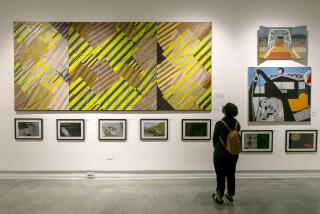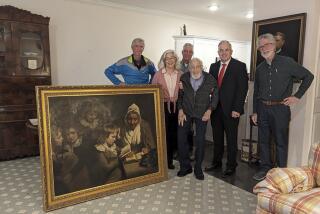Ex-UCLA Official Indicted in Sale of Artwork to N. Y. Gallery
- Share via
A former director of counseling at UCLA has been indicted for allegedly stealing an original 19th century oil painting from the university and selling it to a New York art gallery, authorities said Wednesday.
Jane Crawford is accused of stealing “Frost Flowers, Ipswich 1889” by American painter Arthur Wesley Dow, Assistant U. S. Atty. Ranee Katzenstein said.
Crawford, 50, of Van Nuys, was indicted late Tuesday in U. S. District Court in Los Angeles on five counts of fraud. According to the indictment, Crawford stole the painting in 1994 and sold it through a middleman to the Spanierman Art Gallery in New York City for $200,000.
In a telephone interview with The Times, Crawford denied stealing the painting and said she had yet to be informed of her indictment.
Crawford said the painting hung in her UCLA office for months and that a university official whom she declined to name told her that she could take it home to keep.
“I acted in good faith, believing I had been given an unclaimed painting,” she said. “Eventually I did sell it. I certainly did not know that the university had a claim to it.”
Katzenstein said Crawford had a business dispute with the person who helped her sell the painting. As a result, the prosecutor said, he told local authorities the piece was stolen. The man, who has since died, was not named in the indictment.
Spanierman officials had no knowledge of allegations that the painting was stolen, authorities said.
Crawford, who spent 23 years at UCLA, said she retired last month from her academic counseling position “in response to this whole controversy and problem.”
Harlan Lebo, a UCLA spokesman, said the university has cooperated fully with the investigation, but declined further comment.
Dow, a painter and printmaker in the late 19th and early 20th centuries, was a seminal figure in the early American modernist movement, but less for his own works than the influence he had on others as a teacher.
He was chairman of the Department of Fine Arts at Columbia Teachers College from 1904 until his death in 1922.
His most famous student was Georgia O’Keeffe, who enrolled at the school in 1914 specifically to study with Dow, according to officials at the Georgia O’Keeffe Museum in New Mexico. She later credited him with being the strongest influence on the development of her art.
Dow also taught highly regarded American painter Max Weber.
Perhaps Dow’s most important legacy, however, lies in the fact that he passed down his ideas about art to numerous students who in turn taught art history and appreciation at public schools and colleges across the country.
“The point where Americans stop being impolite about a work of nonrepresentational art and say, ‘I see, it’s a design,’ is thanks to Arthur Wesley Dow,” said Joseph Masheck, art professor at Hofstra University on Long Island, N. Y.
Masheck wrote the introductory essay for the recent re-release of Dow’s 1899 book, “Composition.”
“He got people to realize that the composition, the structure of an image was worth looking at,” Masheck said.
In recent years, Dow’s own works--which often show a strong Japanese influence--have become more highly valued.
“A few years ago, I don’t think it would have been possible for one of his paintings to go for $200,000,” Masheck said. “Only scholars knew his name. But in the last two or three years, he has been rediscovered.”
More to Read
The biggest entertainment stories
Get our big stories about Hollywood, film, television, music, arts, culture and more right in your inbox as soon as they publish.
You may occasionally receive promotional content from the Los Angeles Times.












